Blog
What 3 years of driving an electric car taught me about range “serenity” and energy consumption
It’s been more than 2 years since I described here how I selected a battery electric car model to meet my personal needs: a retail price below €50,000, a type-approval electric range of more than 300 km, and a fast-charging capability of at least 150 kW. In a few weeks, I’ll return my vehicle to the dealer as it’s the end of the 3-year lease period.
So, how was it? In short, pretty uneventful. I never suffered from range anxiety. Most of the time my battery range was more than enough just relying on my Wallbox charger at home. And if I really needed some extra juice, there was always a public charger nearby. I’d describe my experience as one of range serenity instead of range anxiety.
My experience matches the conclusions of a recent ICCT study which found that a car with a battery on the smaller end of the range of capacities on the market is sufficient for the vast majority of urban and rural car drivers. I feel that driving an electric car nowadays is not substantially different from driving a conventional combustion engine car, except that the electric car is quieter, cleaner, and the exceptionally strong torque is more fun to drive!
What about the real-world energy consumption of my electric car? From previous analyses we know there’s roughly a 14% gap between official (Worldwide Harmonized Light Vehicles Test Procedure [WLTP]) values and real-world fuel consumption and CO2 values for conventional gasoline and diesel cars. For plug-in hybrids, the difference is larger and these typically consume three to five times more fuel than advertised by official test values. In the European Union, all new combustion engine vehicles must report anonymized real-world consumption values via on-board fuel consumption meters and statistically meaningful results are accessible to the public. Battery electric vehicles are still exempt, though, and that unfortunately leaves us with a data and knowledge gap.
I kept track of my own real-world consumption values and Figure 1 summarizes my observations. For this chart, I also used data from Spritmonitor.de, a free public platform that’s well known and commonly used among vehicle owners, especially in Germany where I live. Based on a total 13,000 km of driving and a total of 2.4 MWh of electricity that I tracked as part of 50 re-charging events over more than 2 years, my average real-world electricity consumption was 18.7 kWh/100 km. The fluctuation throughout the year is interesting: During the summer months, my average consumption was as low as 14 kWh/100 km, and in December the average was nearly 26 kWh/100 km. It’s also important to note that my electric vehicle is equipped with a heat pump that uses electric energy more efficiently to heat the cabin and battery in winter.
Figure 1. Energy consumption values for my electric car over more than 2 years, from left to right: monthly average variation, official WLTP value, my own real-world consumption, average on-board computer value, and average reporting of Spritmonitor users.
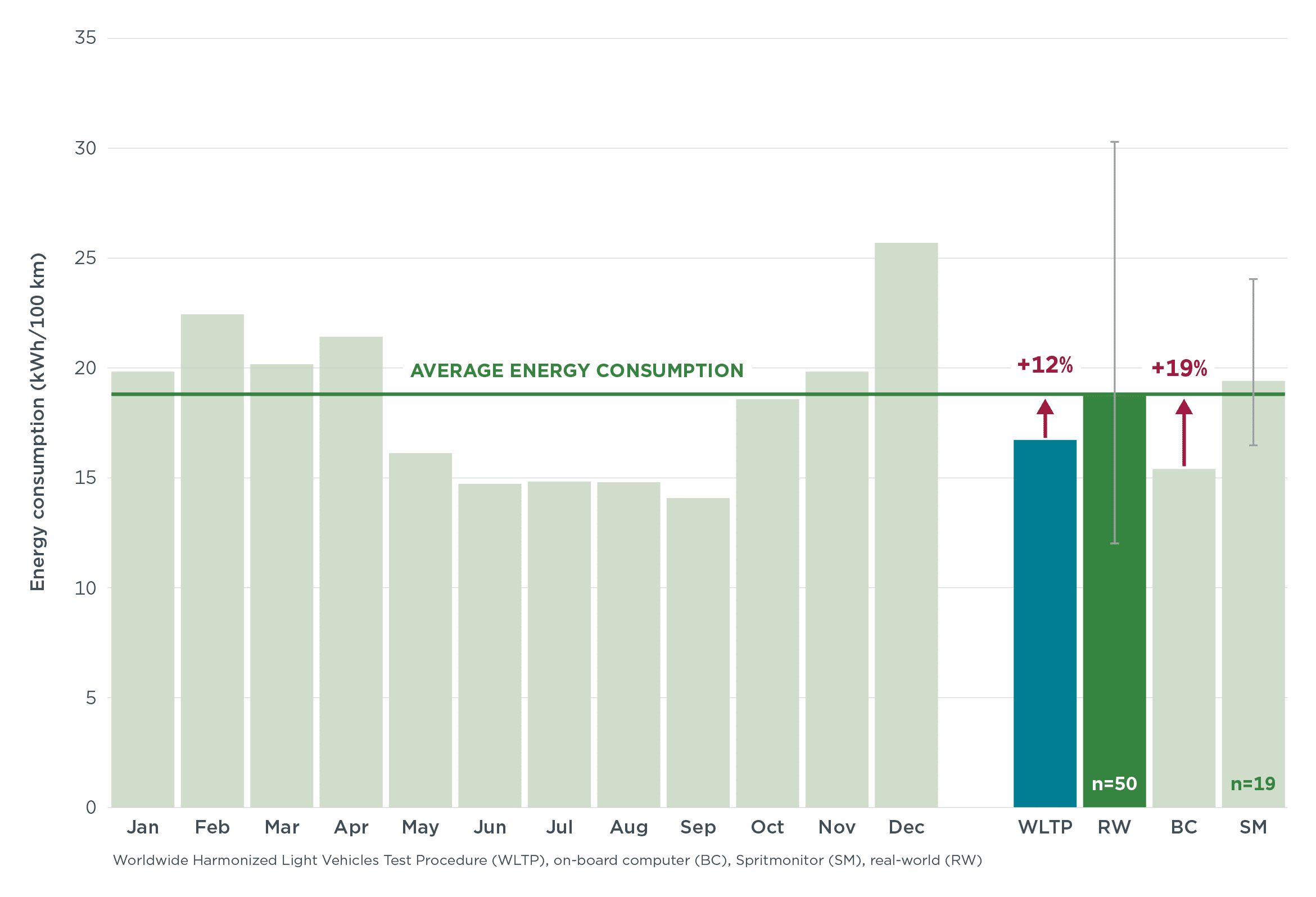
Compared with other drivers on Spritmonitor who have the same vehicle model configuration (58 kWh battery, 125 kW electric engine), I am pretty much average. Leaving two extreme outliers aside, there are 18 other Spritmonitor users who reported average energy consumption values between 18.4 and 23.1 kWh/100 km, with an aggregated average of 19 kWh/100 km.
Comparing my own real-world energy consumption with the official WLTP type-approval value (16.7 kWh/100 km), I am about 12% above. There isn’t much data from Europe to compare my findings with, but in a comprehensive study from China, my ICCT colleagues found a real-world energy consumption gap of around 10%–20% with WLTP for most passenger cars, and my 12% falls nicely into that range. And it’s re-assuring that the real-world gap for my electric car is a bit lower than the 14% we found for combustion engine cars in a recent study.
What I find worrying, though, is what I consider to be a large gap between the average energy consumption value the on-board computer of my car shows (15.6 kWh/100 km) and the real-world value I observed. This difference is about 19%. Most likely, the most important contributing factor here are losses in the on-board charger of the vehicle that occur when re-charging at an A/C charger such as the 11 kW Wallbox I have at home. According to studies, these charging losses add about 17.5% on average to the real-world energy consumption of a battery electric vehicle.
A closer look at my typical driving patterns helps understand my real-world energy consumption and how an electric vehicle works in practice. Figure 2 shows my most typical driving pattern, an inner-urban trip through the flat suburban surroundings of Berlin of about 20 minutes driving and 10 km one-way distance. I take this kind of trip about four times per week, back and forth, and that adds up to about 4,000 km per year. As shown in the figure, velocity jumps up and down—there are many stops, and my maximum speed was about 60 km/h. During these trips, the state of charge of the vehicle’s battery only drops by about 2 percentage points.
Figure 2. My most typical driving pattern, an inner-urban trip. The blue line shows vehicle speed over time and the red line shows the state of charge of the vehicle’s battery.
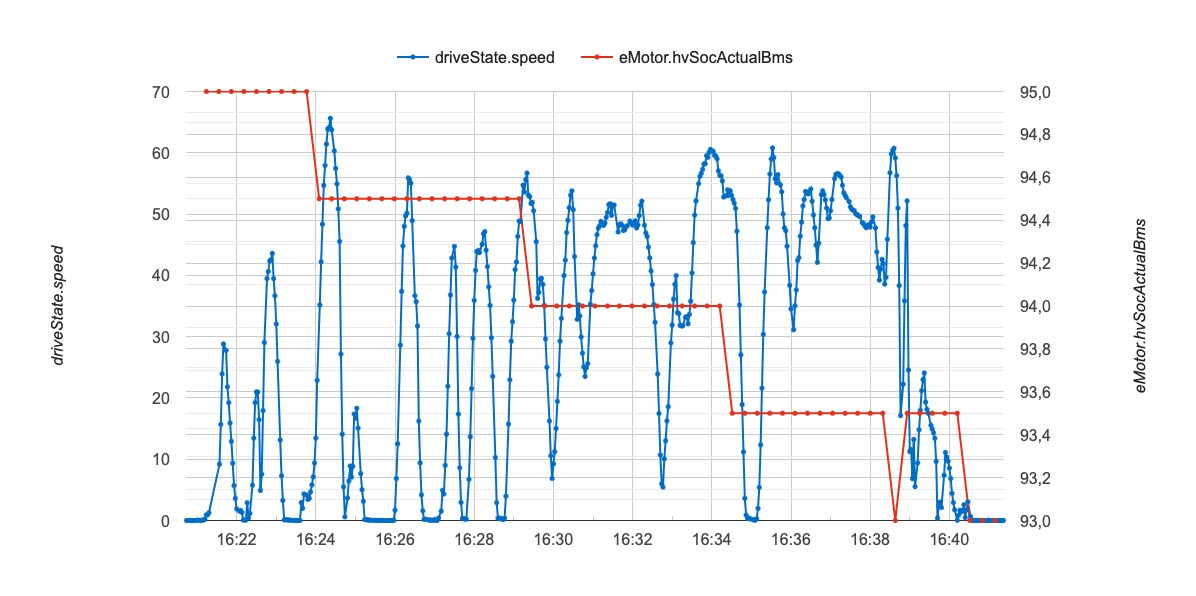
Figure 3. A typical extra-urban trip (with a portion of urban driving) that I take about once per week. The blue line shows vehicle speed over time and the red line shows the state of charge of the vehicle’s battery.
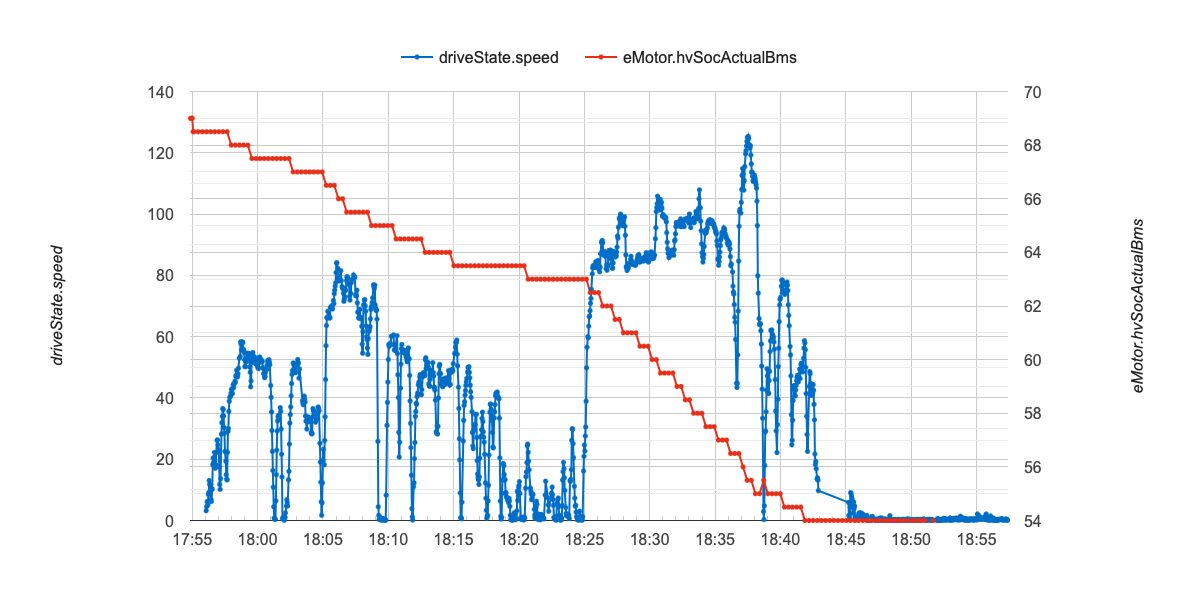
For both trip types, the range of my vehicle is fully sufficient. Indeed, I typically deplete the battery by only about one-third per week and end up re-charging once every 2 or 3 weeks. Therefore, for most of the year, a vehicle with a smaller battery would satisfy my needs, and that’s fully in line with the findings of our recent ICCT report modeling different electric vehicle configurations and user types.
About twice per year I take a long-distance trip to Southern Germany. This ends up being 550 km of driving one way, most of that on the highway, and speeds get up to 170 km/h. Due to the high highway energy consumption of my vehicle, I do two re-charging stops of about 25 minutes each—barely enough to go to the toilet and eat a snack. At the end, I plug the car into an A/C Wallbox so it can slowly re-charge overnight.
Figure 4. A typical long-distance trip I take about twice per year. The blue line shows vehicle speed over time and the red line shows the state of charge of the vehicle’s battery.
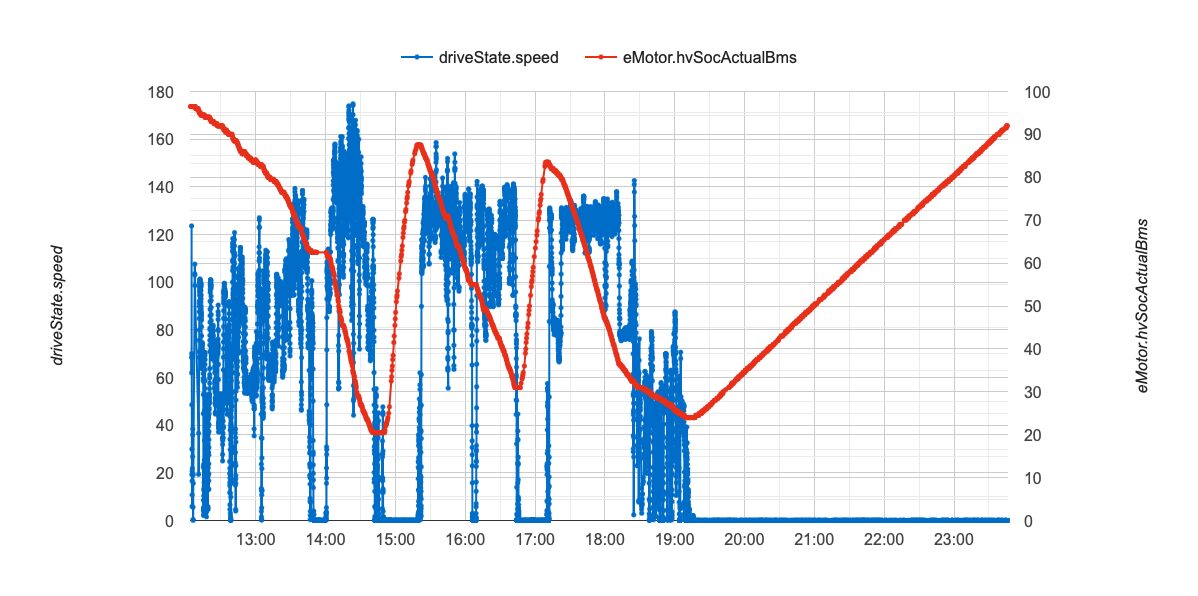
All told, I drive about 10,000 km per year, and this is about 50% urban, 40% extra-urban, and 10% highway. Compared with the WLTP type-approval cycle, I perform less highway and more city driving, and that could explain why my real-world energy consumption is only 12% higher than the official value. According to Green NCAP, for example, my vehicle model has an average energy consumption of 30.2 kWh/100 km for highway driving; this results in an average energy consumption of 22.5 kWh/100 km or 35% higher than the type-approval value.
A large variability in the differences between real-world and type-approval energy consumption of electric cars was also reported in a recent test summary by the German car drivers association ADAC. The ADAC results show that it’s not only personal driving patterns that matter but also the effort a manufacturer puts into optimizing the vehicle toward real-world driving rather than the official test procedure. This, I find, is a good argument for future regulation of real-world energy consumption.
Author
Related Publications
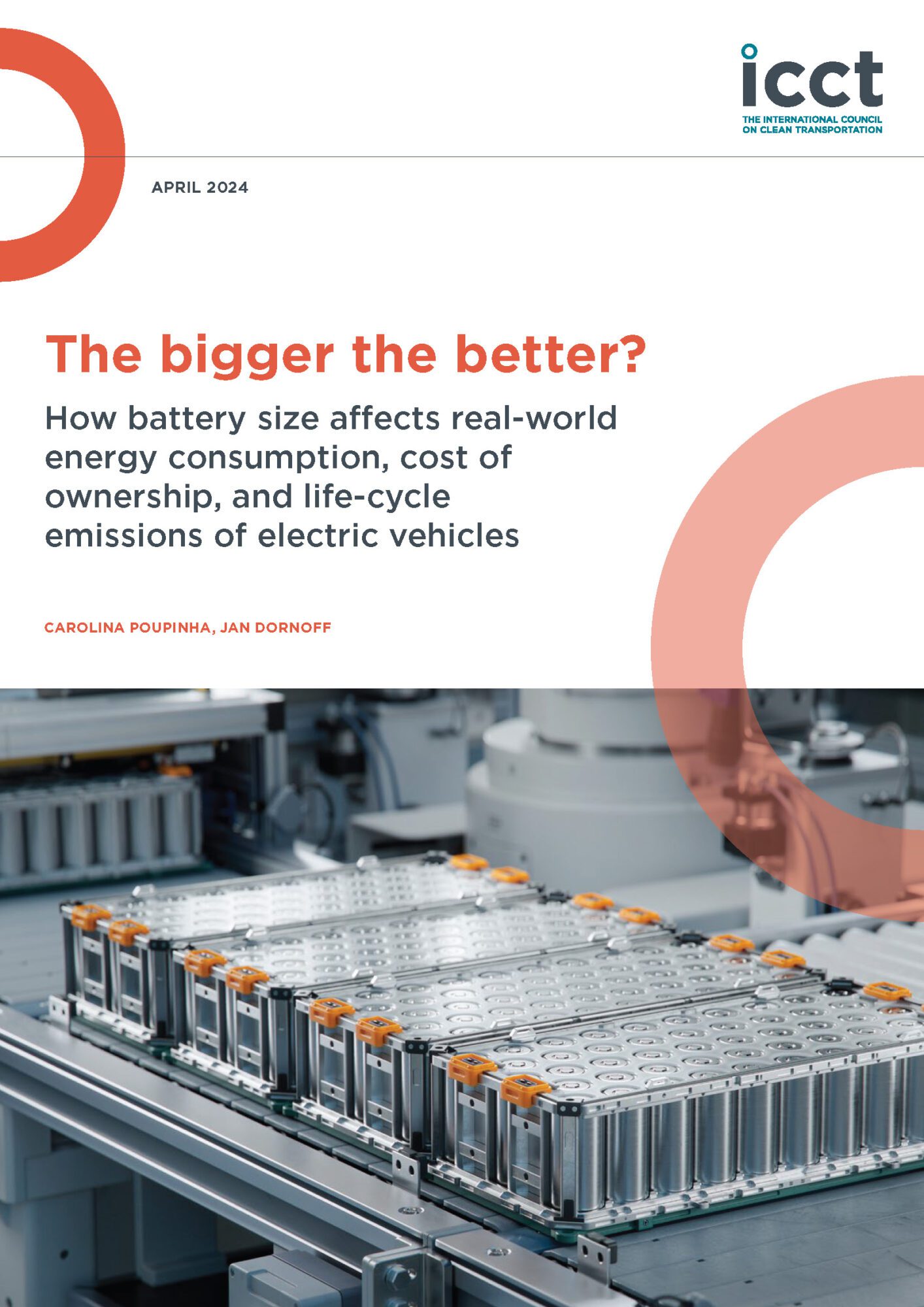
Assesses the impact of varying battery sizes on the real-world energy consumption, cost of ownership, and life-cycle emissions of electric vehicles.

